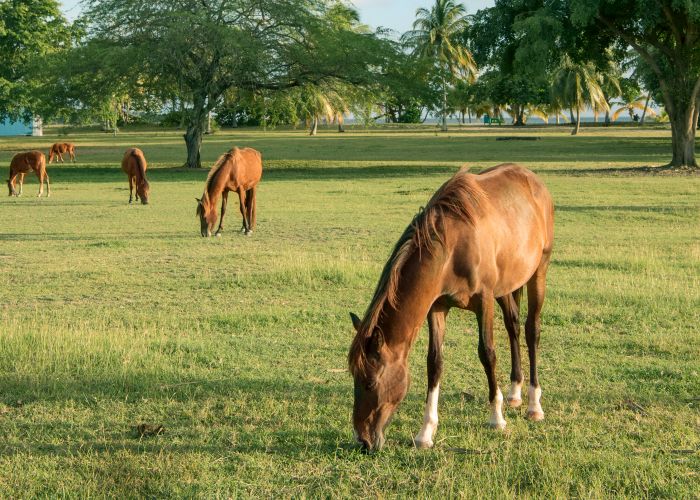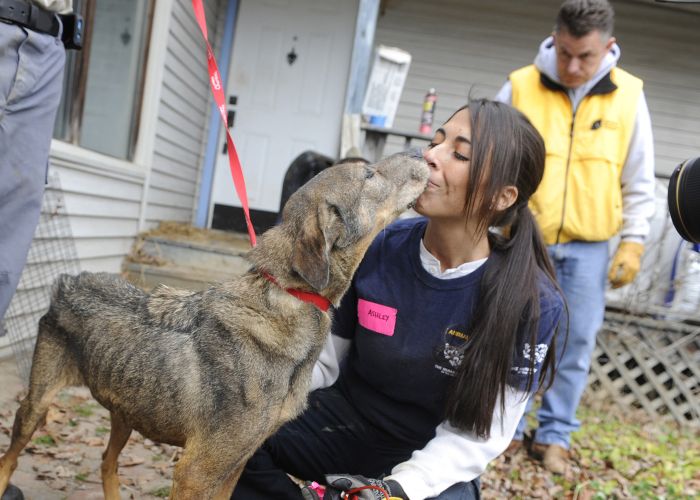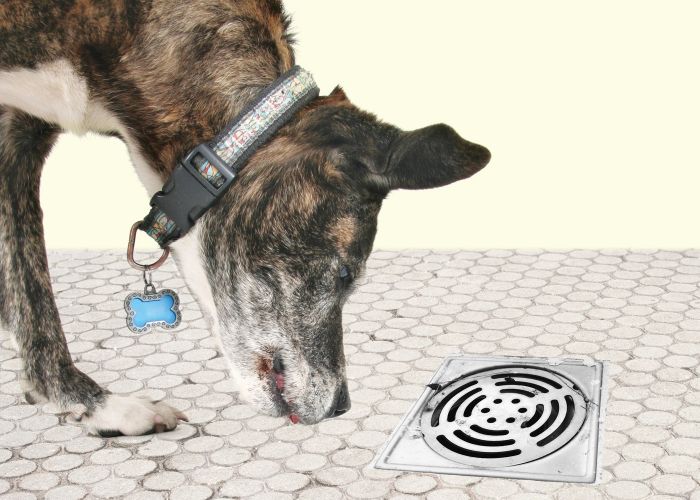Below the rim
In a remote canyon community in Arizona, Humane World brings help to working horses
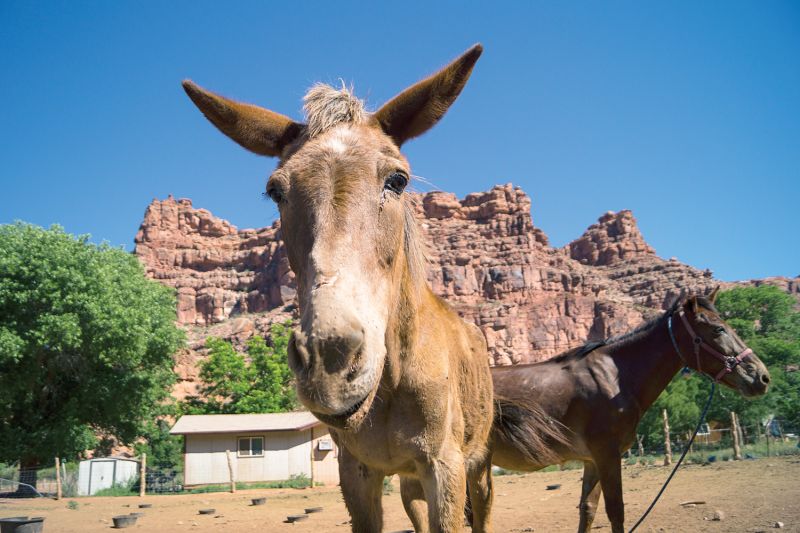
From the trailhead that leads to Havasu Falls, you can gaze over a vast, wild place still largely unaltered by humans. From the edge of the canyon, looking out at the towering stone ridges and the sun-speckled desert valley, listening to the wind whistle around the rocks, it seems like it could be 100, 1,000, even 10,000 years ago, when this isolated Arizona chasm leading to the Colorado River and the Grand Canyon would have looked much the same.
Then, from far across the canyon to the north, there’s a tiny movement, so small at first that it looks like an insect hovering over the canyon floor, closing the distance, growing larger until its outlines become clear. Its rotating blades slice up the silence as it swoops in, deafening, churning up clouds of dust as it lands on the helipad, the staging area around it cluttered with piles of backpacks and camping gear.
Here, sunburned and dusty trekkers mingle with members of the Havasupai tribe coming and going from Supai, the tiny town hidden in the canyon. The locals are headed to and from jobs and doctor’s appointments and supply runs in neighboring towns—“neighboring” being a relative term, as the closest place with a rudimentary grocery store is Peach Springs, some 70 miles away.
At the trailhead, a group of hikers lean with their arms around each other and yell “Cheese” for the phone one of them extends on a selfie stick. Photos taken, the cluster loosens, each hiker turning to start down the rough trail that winds across the desert.
Some hikers carry backpacks, but many of them carry next to nothing. To get materials into the canyon, people have three options: They can carry them in, hauling them over eight hot miles of rocky switchbacks and loose gravel. They can pay to have the chopper haul in their supplies. Or they can hire a packer—members of the Havasupai tribe that owns this land, who run pack horses and mules from the rim into town. From the edge, you can occasionally spot little packs of equines on the trails far below, kicking up clouds of pale dust as they swiftly pass the hikers whose tents and hot dogs and beer they’re carrying ahead.
It’s these horses and mules who have brought Humane World Arizona state director Kellye Pinkleton, along with a team of volunteer veterinarians and horse advocates, to Supai. They are the reason that, among the piles of camping gear piled up for chopper rides into the canyon, there are bales of hay, bags of feed, salt blocks and packs of veterinary tools—brought here so that the team Pinkleton has assembled can provide sustenance and services to the animals, and ideally kick off a long-term working relationship with the Havasupai tribe.

A hidden world
Visitors are drawn to the canyon by the otherworldly beauty of waterfalls formed by Havasu Creek. Minerals in the rocks react with carbon dioxide and water to make the creek shine the radiant teal of a robin’s egg, made all the more luminous by the red rocks and green vegetation that hug the creek. In a series of descending pools, locals and tourists alike float and splash amidst a vista that seems like something out of a dream.
But for decades, visitors to Supai have returned not just with stories of beauty, but of ugliness—troubling accounts of pack horses who were severely underweight, had open wounds, stood in the sun for hours with no shelter or water, were being run too hard and packed too heavy, or strapped with ropes and bands that chafed their skin to rawness.
A particularly egregious case finally drew enough outrage from the public and local advocates that in 2016, the federal government got involved. The FBI arrested a member of the Havasupai tribe and seized four of his horses, who were severely underweight; one had bad wounds along his spine caused by the friction of baggage and ropes against his skin. It was believed to be the first federal prosecution for animal cruelty on tribal land. The seized animals went to Coconino Humane Association in Flagstaff for medical care and rehabilitation, and The HSUS provided a grant to help cover their care.
The tribal economy—the falls are on the Havasupai Reservation—has come to depend on tourist dollars, so the combination of local advocates raising awareness, tourists leaving negative reviews and the media reporting on the case had an impact. The tribe hired a PR firm and shut down packing operations for a few months to try to make improvements in the animals’ care and institute a licensing program for the outfitter companies using horses. These days, there are mixed opinions about whether the case drove any real change, along with disagreements about how pervasive the problem really is, and about how to solve it.
The tribe struggles with many of the challenges common to underserved areas — challenges exacerbated by the remoteness of the location.
Abbie Fink, vice president of Phoenix-based HMA Public Relations, speaking on behalf of the tribal council, says that the majority of the Havasupai are responsible owners who provide their horses with proper care, “but a small number of tribal members don’t share this sense of compassion,” she notes. “There have been some instances where the horses’ health and well-being have been compromised.” And of course, it’s the terrible cases that tend to get the most attention. “With social media now, you get all of it in real time, but with no context,” says Fink.
News stories and social media have brought needed attention to the issue, but the context is critical. The tribe is a tiny population (730 members, around 500 of whom live in the canyon), and they are no strangers to the mixed blessing of outsiders. While the tribe now relies heavily on the influx of tourist dollars, the overall history of the tribe’s encounters with outsiders has not been beneficial to its members.
Established by the U.S. government in 1880, the confines of the Havasupai Reservation forced the Havasu Baaja (the name means “People of the Blue Green Water”) to live on the canyon floor when they had previously moved seasonally between the canyon and the plateaus above, following the dictates of the harvest and animal movements. A 1975 lawsuit expanded their territory, but the long history of outsiders trying to force them to change where and how they live—in ways that had more benefits for the outsiders than for the Havasupai—has had ramifications.
In addition to this historical baggage, there is no veterinarian in Supai and no feed store. The tribe struggles with many of the human challenges common to underserved areas—challenges exacerbated by the remoteness of the location.

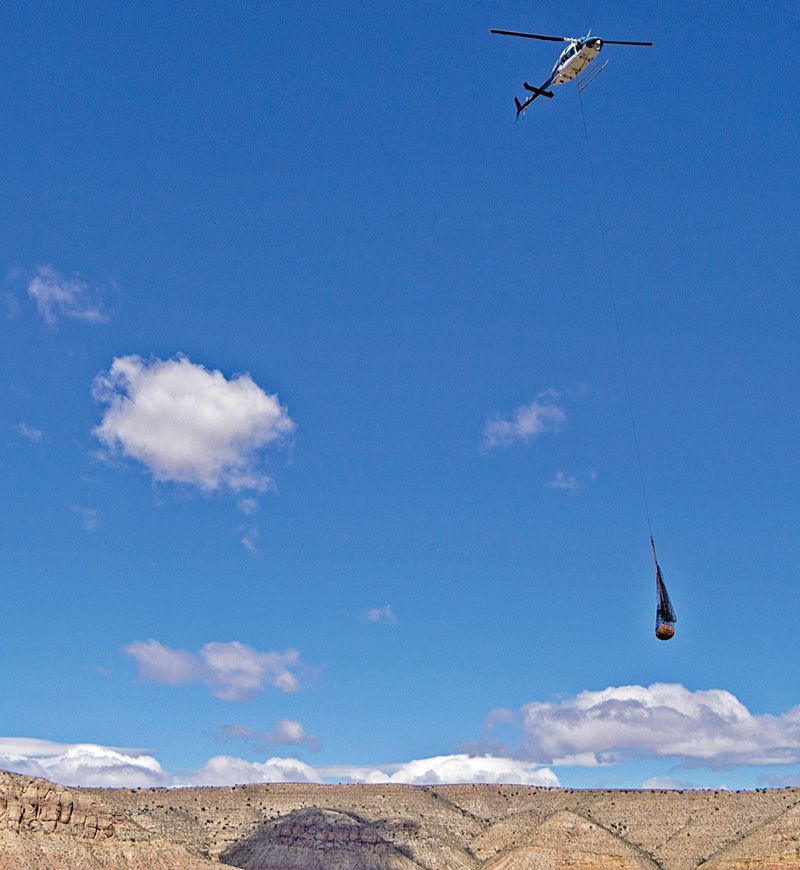
The right kind of help
In 2016, Pinkleton pulled out of a coalition that had come together to try to help the Supai horses. The group had good intentions, she says, but its approach was marked by an attitude suggesting that—rather than being mostly the result of economic deprivation and lack of access to resources—the poor condition of Supai’s horses was due to callousness and apathy on the part of the tribe as a whole.
That attitude, unsurprisingly, didn’t play well. There’s a complex web of federal laws governing how federal agencies interact with reservations, but tribes are essentially nations, and their tribal councils get to decide who can work on their land. They’re less likely to welcome animal advocates they see as offering help with one hand and a slap in the face with the other—“coming into their home and then insulting them and their home,” points out Fink.
The situation is a complicated one—economically, culturally, geographically—and Pinkleton recognized that it needed to be addressed accordingly.
“The HSUS always has a hammer if we need it, but walking in with a hammer doesn’t work in every situation,” she says. “And it certainly doesn’t work when essentially what you’re trying to do is open a line of communication and establish a relationship with a sovereign government.”
Determined to make headway, she began talking to Fink and the tribe’s attorney. “It was a chance for them to find out a little more about HSUS—what were our intentions, and quite frankly, to determine if we would be a safe partner to work with. Was this really about working in collaboration and partnership?”
The tribal council agreed to meet with Pinkleton. On her visit, she listened to their concerns and explained how The HSUS planned to approach the problem. In May 2017, with the tribe’s consent, she took a group of volunteers into Supai, including private-practice veterinarians, advocates, farriers and horse rescuers from Healing Hearts Animal Rescue and Equine Voices Rescue & Sanctuary.

Work in progress
Right off, the team got a taste of the logistical realities of the reservation. They’d planned to be in town by noon and start working with the horses immediately, but hit the transport bottleneck, waiting three hours at the rim to catch the chopper down. Once in the canyon, they discovered that most of their equipment was still up top; by the time all the gear had gotten in safely, it was early evening.
Well-fed by reps from the Wildland Trekking Company (which helped sponsor the trip), the volunteers went to bed early, spreading sleeping bags in an empty house provided by the tribe or pitching tents at the campground. Most were up with the sun the next morning, setting up at a storage supply shed to wait for new clients and their horses.
At first, the team worried that few would show up for services. Staff working in underserved communities often find it takes a lot of relationship-building and repeated visits to gain trust in neglected neighborhoods. Locals used to seeing outsiders only in an enforcement capacity often fear that any official-looking stranger is actually there to get them in trouble or take their animals.
But as the morning went on, locals began to arrive, leading their horses into the small lot, where farrier Robert Holden and his son Cory began trimming overgrown hooves, and veterinarian Richard Fisher and assistant Rick Wesley worked on the horses’ teeth. (Dental issues can be a factor in horses who are underweight: Sometimes what looks like a failure to provide enough food is actually caused by bad teeth making it difficult for the animal to eat.)
Veterinarian Laura Harris provided animals with dewormer and vaccinations. She met lots of locals, including Jordan Manakaja, whose horses were shiny and healthy-looking. Manakaja explained that one of them was a former pack horse taken in when the animal was in poor condition. Manakaja had fed and cared for the animal until he was in good health again.
While the team didn’t visit or treat all the horses living in the canyon, Harris says she didn’t see anything truly egregious among the horses the team did treat. She believes it’s not realistic to hold people in such a remote location, coping with such scarce resources, to the standards that would apply in more affluent, accessible areas. In Scottsdale, where her practice is based, you can get a vet almost immediately, compared to Supai, where there’s no vet within 100 miles. Certainly the horses she treated in the canyon “were a little thinner than horses you’re used to seeing in the rest of the U.S., or certainly in Scottsdale where you’re used to seeing the opposite issue,” but most of them weren’t underweight to the degree that it was a medical issue. “The vast majority of the people in Supai are just like everyone else—they’re nice people who are doing the best they can,” she says.
The minority, though, can do real damage to horses and the tribe’s reputation. Tina Hanna, the town’s main animal control officer, describes how a packer’s horse once collapsed in front of the town post office, in full view of dozens of tourists. “Thanks to social media, tourists worldwide now know us as a place of animal cruelty,” she says sadly.
She says that employers among the packing operators need to crack down on bad actors, so that animals who are injured don’t continue packing until they’ve fully recovered. While she knows well the difficulty of taking action in a tiny town where everyone knows each other, until rules about animal care are enforced consistently, she thinks stories of horse cruelty in Supai will continue to circulate.
Still, it’s clear there are locals who care about the issue, especially some of the younger generation. The team has only been working for an hour when a pair of teenagers approaches, pushing a wheelbarrow full of puppies, mewling and climbing all over each other. The kids ask the team to take them, explaining that they won’t get good care in the canyon. They ask if future visits will bring help for pets as well as horses.
That plan is in the works, Pinkleton confirms. There are also plans to provide shade stations, horse-care training scholarships for selected tribal members, an education forum and more, in partnership with the tribal council and Supai community.
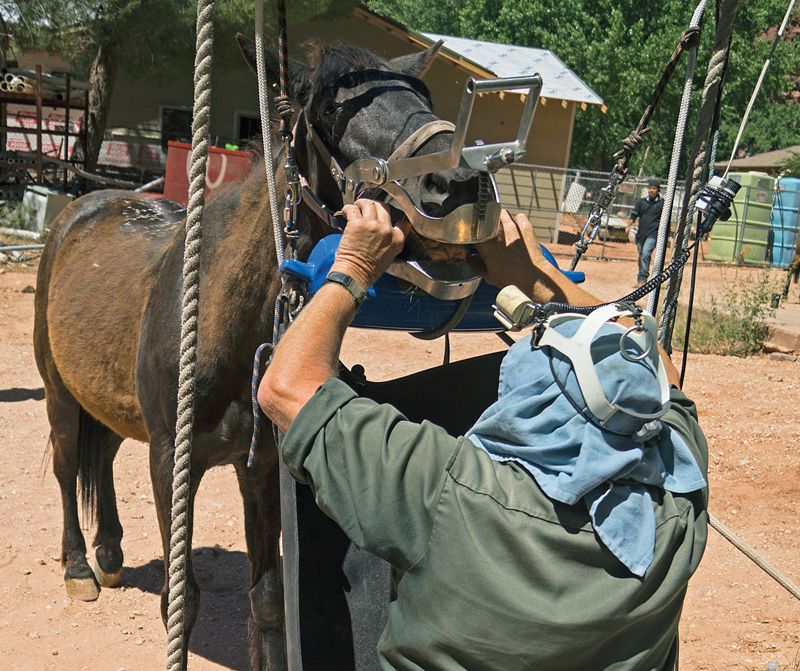
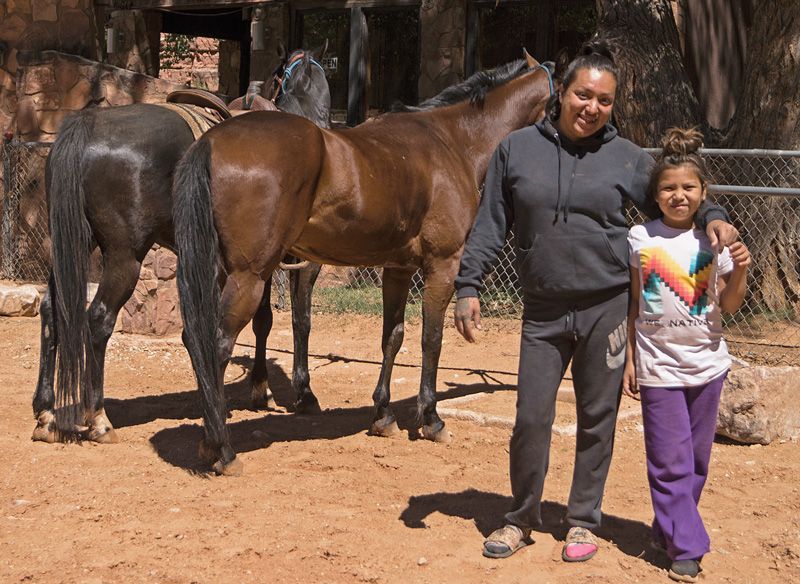
Making it last
By the end of the weekend, the team had treated 70 horses, doing everything from teeth extractions and hoof care to vaccinations and deworming. They’d connected with Coconino Humane, which agreed to take in the wheelbarrow pups.
Many of the volunteers expressed happiness about what they’d been able to do. The challenge is making the work sustainable—because the realities of the reservation remain: It’s difficult to reach, there’s no veterinarian in the canyon, there are major economic challenges. Hanna has been to a cruelty response training workshop The HSUS conducted with the Maricopa County sheriff’s department, Pinkleton says, and while the team was at work, both she and her young assistants, Darius and Lone Arrow, were on hand, watching the farriers trim hooves and learning about other equine health issues.
“If [our animal control officers] could be trained in those and vaccinations and worming, that would be a good benefit for the community,” says Don Watahomigie, chair of the tribal council, “because a lot of the horses will get worms, or they’ll get an injury that requires penicillin.” While it’s not the same as having a veterinarian nearby, training and better access to veterinary supplies would ensure there’s someone who can provide basic grooming, wellness and first aid.
On the last day, the team got up before dawn to wave goodbye to the volunteers from Healing Hearts Animal Rescue and Equine Voices Rescue & Sanctuary, who had taken on a final task: One local horse was in particularly rough shape and had gone blind, and an advocate had contacted Hanna for help. Equine Voices agreed to take the horse. With Darius as their guide, they set out through the dark, leading the blind horse across the desert and up along narrow switchbacks to the canyon rim where they’d started days before.
The horse was leaving the canyon forever. The team hopes to go back and do more, working with the Havasupai to care for the horses who, for hundreds of years, have helped the tribe survive in this hard but beautiful place.


